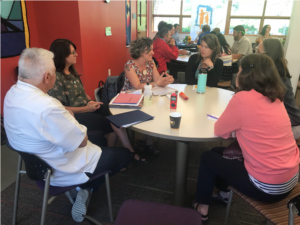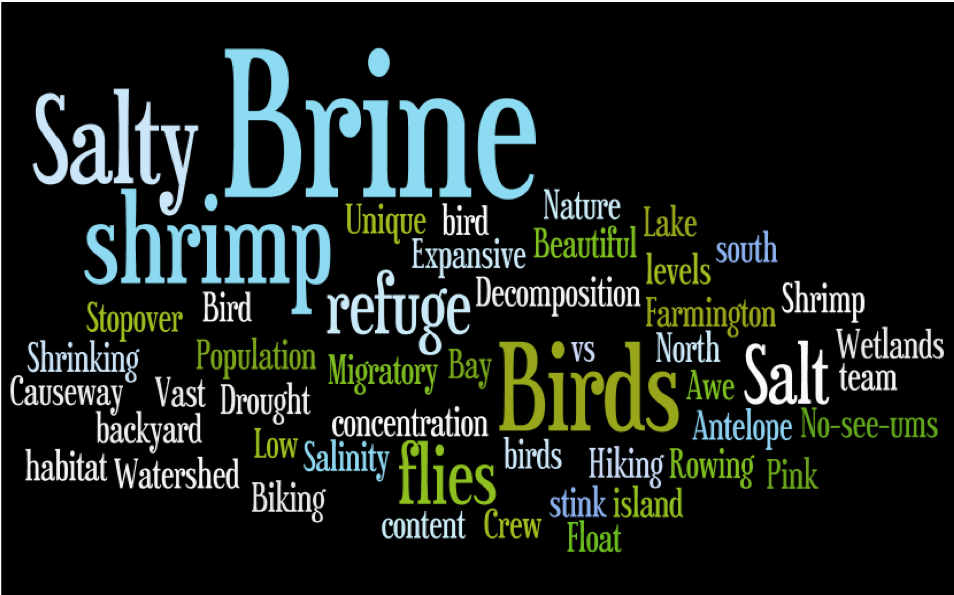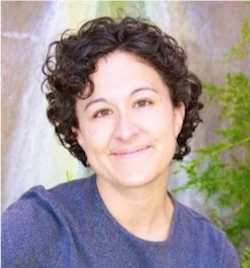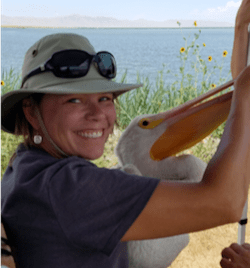By Skye Sieber and Jaimi Butler for EDRBlog.org
Earlier this summer, we attended the Dialogue on Collaboration focused on Great Salt Lake. One prominent theme we heard and that collectively emerged during the individual small group discussions was the lack of (and need for) greater public awareness about the importance of Great Salt Lake. While close to three-quarters of our state’s population lives within 60 miles or so of the shoreline, only a small minority of Utahns are aware of just how significant the lake is – ecologically, economically, and culturally. This statistic may be related partly by a lack of experience (have never visited the lake) or a bad experience (such as visiting Antelope Island State Park in the spring during gnat season—tiny biting flies that resist insect repellent).

As community outreach professionals working on Great Salt Lake issues, not only did we agree with this general disconnect between people and the lake, we decided to embrace it and continue the dialogue by asking a new question: “How can we increase public engagement, understanding, and appreciation of Great Salt Lake?” The annual Utah Society for Environmental Education Conference was a perfect venue to ask for help and engage formal and informal educators in this dialogue.
The two-day conference included a one-hour roundtable interactive session on the first day. We designed a format that would serve as part focus group and part brainstorming. Our process had to be flexible because we didn’t know how many people: 1) would show up to our table (one of five topics during the hour); 2) would stay at our table during the hour; or 3) would join our table while the session was underway. With all of these unknowns and a limited timeframe, we kept it decidedly simple.
Get notified when new articles are posted to the EDR blog – sign up for our email list »
We kicked-off the discussion by asking: “When you hear ‘Great Salt Lake,’ what are the first three words you think of?” We had everyone write their answers on an index card and then share them with the group. This simple question helped “break the ice” and allowed participants to reflect and share their own feelings and perceptions about the lake while elaborating on their answers. Next, we launched into a brainstorming session armed with questions relating to: their audience composition; how they might already be incorporating the lake in their programming; barriers and challenges to teaching about Great Salt Lake; and ideas for how to reach new audiences. During the last five minutes, we opened up the discussion for any last thoughts, ideas, or questions.
We hoped to keep an open dialogue that went beyond our short time at the roundtable session. A week after the conference, we followed-up with participants by sending summary notes, a link to a survey with the brainstorming questions, and a “word cloud” generated from all the words we collected on index cards, which we hope serves as a memorable group token from our short and intense time together talking about Great Salt Lake.

“Word-cloud” courtesy: Westminster College-Great Salt Lake Institute
What did we learn?
One valuable thing about the open dialogue format of a roundtable is that we were able to collect empirical data. It did not come as a surprise that participants knew Great Salt Lake contains salt, as represented by the words: salty, salt, salinity, and brine. Many people also thought of our charismatic brine shrimp, the millions of birds that visit the lake each year on their annual migrations, and who can forget that sometimes the lake smells? Participants were also keen on the fact that the lake is shrinking and is affected by drought: water diversions combined with climate change is the largest threat to Great Salt Lake and the wildlife and humans that live near it.
Perhaps more important were the words that were missing:
Diverse: Salt content of the lake ranges from zero to 27%. This equates to incredible diversity that can support extremophiles in hypersaline parts of the lake, fish in freshwater, and brine shrimp and other macroinvertebrates in between.
Economics: Great Salt Lake has been valued at over $1.2 billion annually. Imagine what would happen if it shrinks to a point there are few viable industries and a need for costly mitigation. We can look to many other desiccated lakes around the globe for examples of such impacts.
Important: Not only is Great Salt Lake important for millions of birds, it is also critical to human health. Less water means more exposed lakebed which becomes a source of dust emissions during wind events. In 2015, the lake reached near records lows, exposing 50% of the lakebed.
As educators, we walked away with a robust list of ideas and places that could be used to help expand awareness about the importance of Great Salt Lake. Retirement centers, mountain bike clubs, family outings are all new and great places to start and we should also remember to time outings to the lake to avoid bad experiences such as the dreaded biting gnats! This could be accomplished by creating a simple guide to the seasons of the lake and places to explore throughout the seasons.
The idea gathering process we designed was simple, flexible, and repeatable. We can employ or adapt the process in different settings with different groups. And, akin to an ongoing survey, we have a set of core questions to help us continually gather new insights and ideas about how to better connect Utahns to Great Salt Lake.
The next time you run into one of us, be ready to join the Great Salt Lake Stink Tank! Have your three words and be prepared to share ideas for places or people you have encountered that may be interested in learning about the importance of Great Salt Lake. The lake is complex and needs a posse of people that can speak for the future of its health.
 Skye Sieber is a Community Development Planner for the Utah Community Development Office, with a focus on supporting Utah’s rural towns and counties. Prior to joining the state, she spent 18 years working on natural resource management and conservation initiatives in the nonprofit and federal sectors and supported the US Department of Interior as a neutral facilitator and mediator. She enjoys designing public meetings and workshops and working with diverse groups of people to find common ground.
Skye Sieber is a Community Development Planner for the Utah Community Development Office, with a focus on supporting Utah’s rural towns and counties. Prior to joining the state, she spent 18 years working on natural resource management and conservation initiatives in the nonprofit and federal sectors and supported the US Department of Interior as a neutral facilitator and mediator. She enjoys designing public meetings and workshops and working with diverse groups of people to find common ground.
 Jaimi Butler is the coordinator of the Great Salt Lake Institute, housed at Westminster College. After graduating with a Fisheries and Wildlife degree from Utah State University in 1999, Jaimi has helped increase knowledge and shape perceptions of Great Salt Lake through work in the private sector, government, and academia. Jaimi’s primary areas of studies include the brine shrimp and bird populations that thrive at the lake.
Jaimi Butler is the coordinator of the Great Salt Lake Institute, housed at Westminster College. After graduating with a Fisheries and Wildlife degree from Utah State University in 1999, Jaimi has helped increase knowledge and shape perceptions of Great Salt Lake through work in the private sector, government, and academia. Jaimi’s primary areas of studies include the brine shrimp and bird populations that thrive at the lake.
